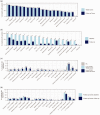Multi-organ impairment and long COVID: a 1-year prospective, longitudinal cohort study
- PMID: 36787802
- PMCID: PMC10041626
- DOI: 10.1177/01410768231154703
Multi-organ impairment and long COVID: a 1-year prospective, longitudinal cohort study
Abstract
Objectives: To determine the prevalence of organ impairment in long COVID patients at 6 and 12 months after initial symptoms and to explore links to clinical presentation.
Design: Prospective cohort study.
Participants: Individuals.
Methods: In individuals recovered from acute COVID-19, we assessed symptoms, health status, and multi-organ tissue characterisation and function.
Setting: Two non-acute healthcare settings (Oxford and London). Physiological and biochemical investigations were performed at baseline on all individuals, and those with organ impairment were reassessed.
Main outcome measures: Primary outcome was prevalence of single- and multi-organ impairment at 6 and 12 months post COVID-19.
Results: A total of 536 individuals (mean age 45 years, 73% female, 89% white, 32% healthcare workers, 13% acute COVID-19 hospitalisation) completed baseline assessment (median: 6 months post COVID-19); 331 (62%) with organ impairment or incidental findings had follow-up, with reduced symptom burden from baseline (median number of symptoms 10 and 3, at 6 and 12 months, respectively). Extreme breathlessness (38% and 30%), cognitive dysfunction (48% and 38%) and poor health-related quality of life (EQ-5D-5L < 0.7; 57% and 45%) were common at 6 and 12 months, and associated with female gender, younger age and single-organ impairment. Single- and multi-organ impairment were present in 69% and 23% at baseline, persisting in 59% and 27% at follow-up, respectively.
Conclusions: Organ impairment persisted in 59% of 331 individuals followed up at 1 year post COVID-19, with implications for symptoms, quality of life and longer-term health, signalling the need for prevention and integrated care of long COVID.Trial Registration: ClinicalTrials.gov Identifier: NCT04369807.
Keywords: COVID-19; integrated care; long COVID; organ impairment; prevention; quality of life.
Conflict of interest statement
The author(s) declared the following potential conflicts of interest with respect to the research, authorship, and/or publication of this article: AD, NE, SF, MP, AR-F, HT-B, MK, MR and RB are employees of Perspectum. All other authors have no competing or conflicting interests.
Figures



References
-
- Yong SJ, Liu S. Proposed subtypes of post-COVID-19 syndrome (or long-COVID) and their respective potential therapies. Rev Med Virol 2022; 32: e2315. - PubMed
-
- Routen A, O’Mahoney L, Ayoubkhani D, Banerjee A, Brightling C, Calvert M, et al.. Understanding and tracking the impact of long COVID in the United Kingdom. Nat Med 2022; 28: 11–15. - PubMed
-
- Al-Aly Z, Xie Y, Bowe B. High-dimensional characterization of post-acute sequelae of COVID-19. Nature 2021; 594: 259–264. - PubMed
Publication types
MeSH terms
Associated data
LinkOut - more resources
Full Text Sources
Medical

